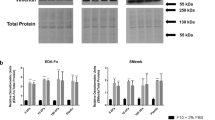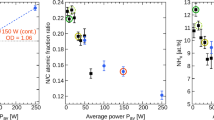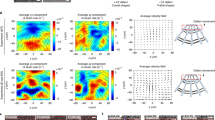Abstract
The monovalent ionophore, monensin, inhibits the secretion of both pro-collagen and fibronectin in cultured human fibroblasts1–3 and other cell types4–7. The block to secretion is due to the ability of monensin to suppress the export of these secretory proteins from the Golgi apparatus3,8,9. As such proteins are known to be implicated in the adhesion, spreading and movement of cultured fibroblasts10,11, it might be expected that monensin treatment would interfere with these processes. However, it has recently been reported9 that monensin-treated human embryonal fibroblasts attached and spread onto glass substrata to the same extent as untreated cells, although at later stages they fail to develop focal adhesion sites. However, these experiments were performed using medium supplemented with fetal calf serum (FCS). We now demonstrate that in the absence of FCS, while monensin has little or no effect on the initial adhesion of fibroblasts to the substratum, subsequent spreading is much reduced. The inhibition of spreading is noticeable within 30 min of plating and is maintained for at least 100 min in monensin-free medium following prolonged pre-incubation of the cells with monensin.
This is a preview of subscription content, access via your institution
Access options
Subscribe to this journal
Receive 51 print issues and online access
$199.00 per year
only $3.90 per issue
Buy this article
- Purchase on Springer Link
- Instant access to full article PDF
Prices may be subject to local taxes which are calculated during checkout
Similar content being viewed by others
References
Tartakoff, A. M. Int. Rev. exp. Path. 22, 227–251 (1980).
Uchida, N., Smilowitz, H. & Tanzer, M. L. Proc. natn. Acad. Sci. U.S.A. 76, 1868–1872 (1979).
Uchida, N., Smilowitz, H., Ledger, P. W. & Tanzer, M. L. J. biol. Chem. 255, 8638–8644 (1980).
Tartakoff, A. M. & Vassalli, P. J. exp. Med. 146, 1332–1345 (1977).
Tartakoff, A. M. & Vassalli, P. J. Cell Biol. 79, 694–707 (1978).
Smilowitz, H. Molec. Pharmac. 16, 202–214 (1979).
Smilowitz, H. Cell 19, 237–244 (1980).
Ledger, P. W., Uchida, N. & Tanzer, M. L. J. Cell Biol. 87, 663–671 (1980).
Virtanen, I., Vartio, T., Badley, R. A. & Lehto, V.-P. Nature 298, 660–663 (1982).
Hynes, R. O. & Yamada, K. M. J. Cell Biol. 95, 369–378 (1982).
Grinnell, F. & Feld, M. K. Cell 17, 117–129 (1979).
Sokal, R. R. & Rohlf, F. J. Biometry 2nd edn (Freeman, San Francisco, 1981).
Jones, G. E. & Witkowski, J. A. J. Cell Sci. 48, 291–300 (1981).
Brugmans, M. et al. Cytometry 3, 262–268 (1982).
Grinnell, F., Hays, D. G. & Minter, D. Expl Cell Res 110, 175–190 (1977).
Ledger, P. W., Nishimoto, S. K., Hayashi, S. & Tanzer, M. L. J. biol. Chem. 258, 547–554 (1983).
Jones, G. E. & Witkowski, J. A. J. neurol. Sci. 43, 465–470 (1979).
Author information
Authors and Affiliations
Rights and permissions
About this article
Cite this article
Pizzey, J., Bennett, F. & Jones, G. Monensin inhibits initial spreading of cultured human fibroblasts. Nature 305, 315–317 (1983). https://doi.org/10.1038/305315a0
Received:
Accepted:
Issue Date:
DOI: https://doi.org/10.1038/305315a0
This article is cited by
-
MAPKAP kinase 2 is essential for LPS-induced TNF-α biosynthesis
Nature Cell Biology (1999)
Comments
By submitting a comment you agree to abide by our Terms and Community Guidelines. If you find something abusive or that does not comply with our terms or guidelines please flag it as inappropriate.



